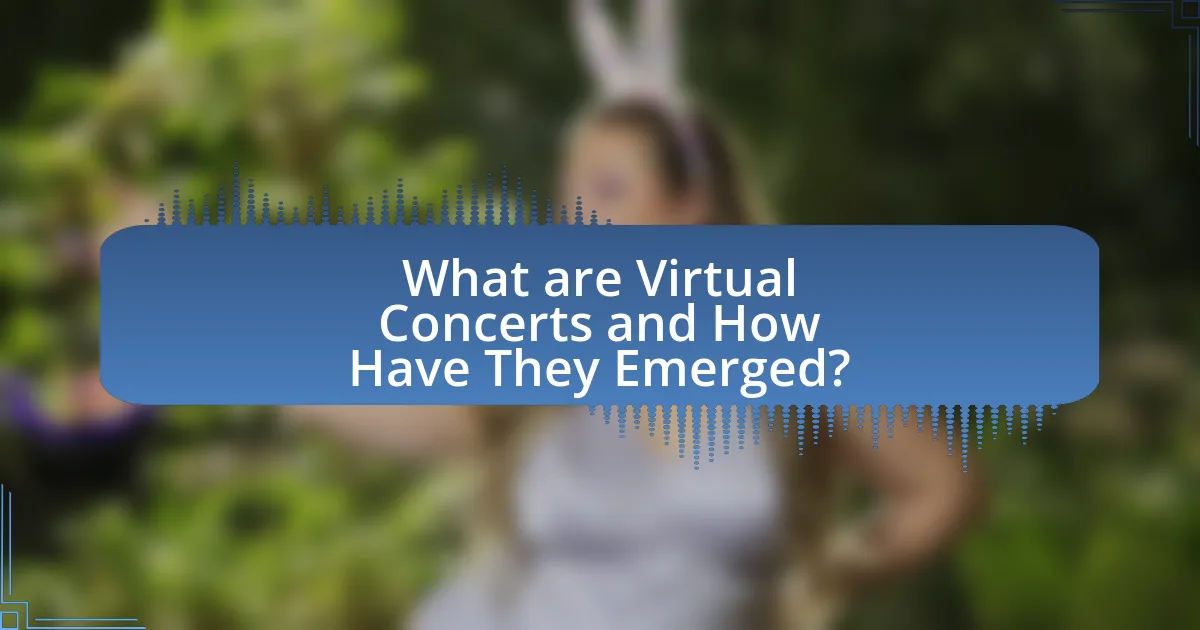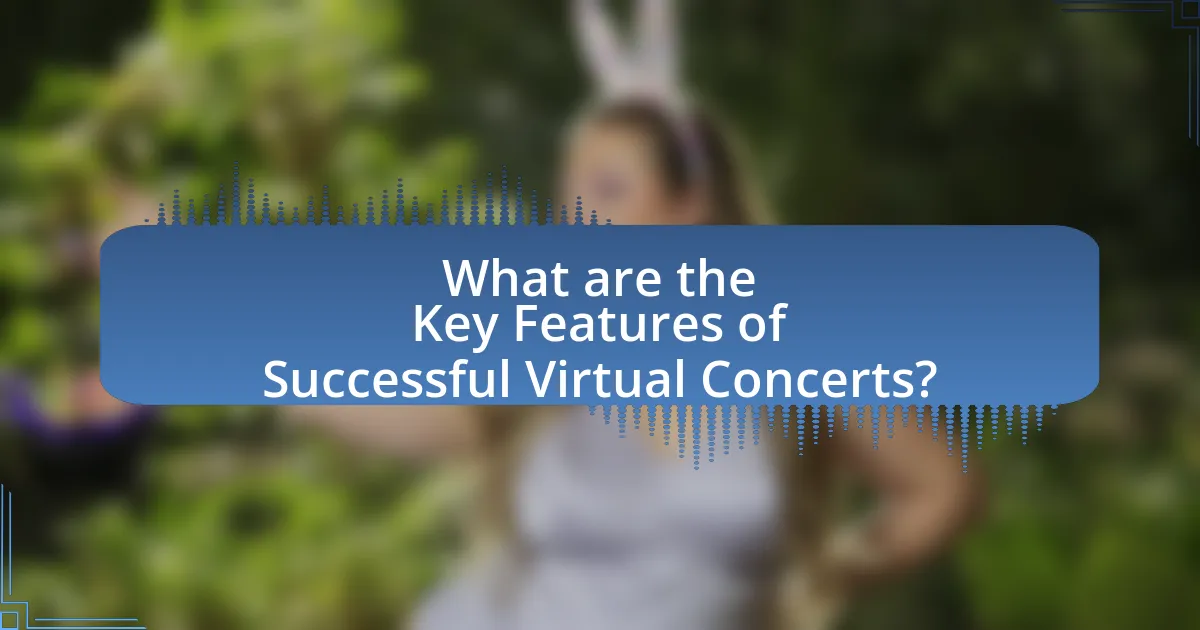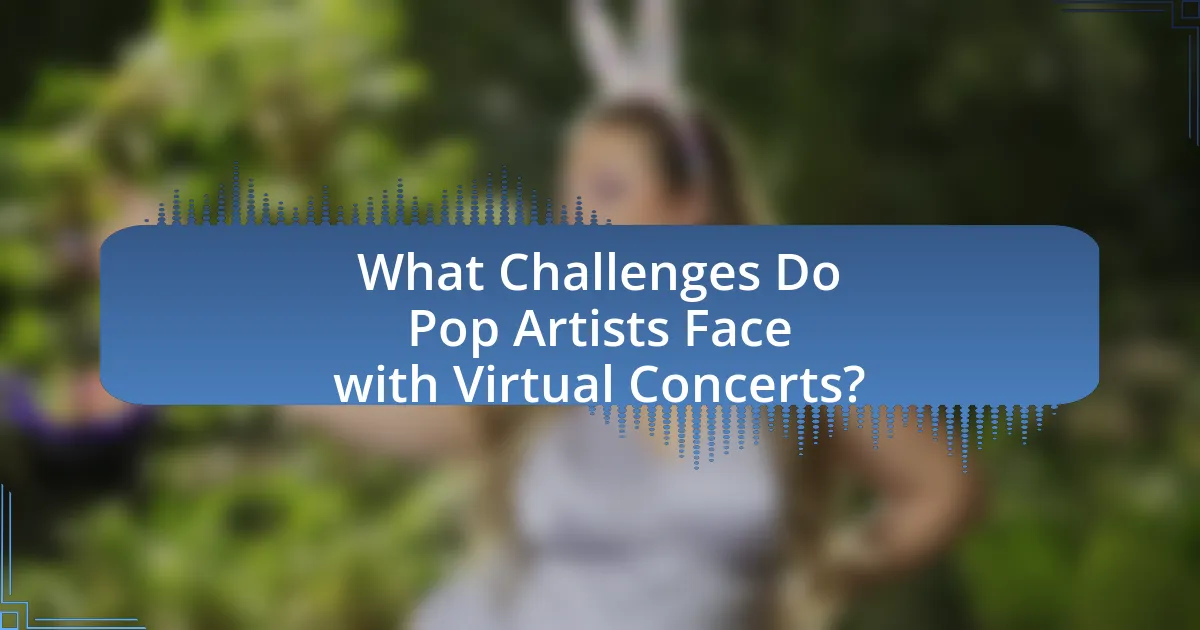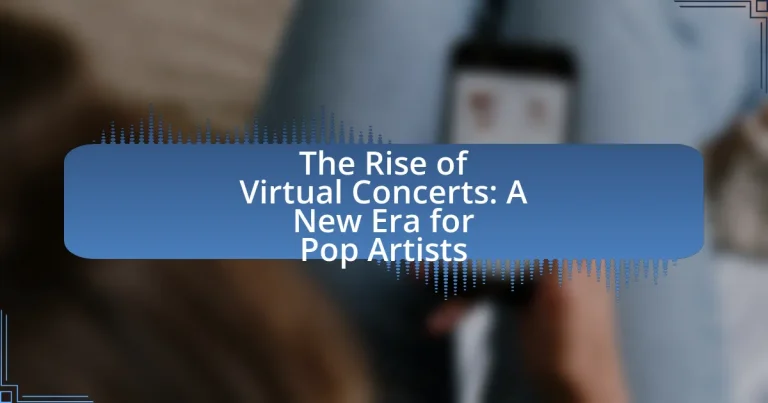Virtual concerts represent a significant evolution in the music industry, allowing pop artists to perform live in digital environments and reach global audiences through streaming platforms. The emergence of this format has been driven by technological advancements and the necessity for social distancing during the COVID-19 pandemic, leading to a market valued at approximately $1.1 billion in 2020. Key features of successful virtual concerts include high-quality production, interactive audience engagement, and effective promotion strategies. The article explores how virtual concerts differ from traditional performances, the role of technology in their rise, and the challenges artists face in this new landscape, while also highlighting best practices for maximizing audience engagement and success.

What are Virtual Concerts and How Have They Emerged?
Virtual concerts are live performances that occur in a digital environment, allowing artists to reach audiences through streaming platforms. They have emerged significantly due to advancements in technology and the necessity for social distancing during the COVID-19 pandemic, which led to a surge in online events. According to a report by Statista, the global virtual concert market was valued at approximately $1.1 billion in 2020 and is projected to grow as artists and fans embrace this format for its accessibility and innovative engagement opportunities.
What defines a virtual concert in the context of pop music?
A virtual concert in the context of pop music is defined as a live or pre-recorded performance that is streamed online, allowing audiences to experience the event remotely. This format gained significant traction during the COVID-19 pandemic, with artists like Travis Scott and Billie Eilish utilizing platforms such as Fortnite and YouTube to reach millions of fans globally. The interactive nature of virtual concerts, often incorporating augmented reality and social media engagement, enhances the audience’s experience, making it a distinct evolution from traditional live performances.
How do virtual concerts differ from traditional live performances?
Virtual concerts differ from traditional live performances primarily in their format and accessibility. Traditional live performances occur in physical venues where audiences gather in person, while virtual concerts are streamed online, allowing viewers to participate from anywhere with an internet connection. This shift enables artists to reach a global audience without geographical limitations, as evidenced by events like Travis Scott’s Fortnite concert, which attracted over 12 million viewers simultaneously. Additionally, virtual concerts often incorporate interactive elements, such as real-time audience engagement through chat features, which are not present in traditional settings.
What technological advancements have facilitated the rise of virtual concerts?
Technological advancements such as high-speed internet, streaming platforms, virtual reality (VR), and augmented reality (AR) have facilitated the rise of virtual concerts. High-speed internet enables seamless streaming of live performances to global audiences, while streaming platforms like YouTube and Twitch provide accessible venues for artists to reach fans. VR technology allows for immersive concert experiences, enabling viewers to feel as if they are physically present at the event. Additionally, AR enhances the visual experience by overlaying digital elements onto the real world, creating engaging interactions during performances. These technologies collectively transform how concerts are experienced, making them more accessible and innovative.
Why have virtual concerts gained popularity among pop artists?
Virtual concerts have gained popularity among pop artists primarily due to their ability to reach a global audience without geographical limitations. This format allows artists to perform live to fans worldwide, significantly increasing their potential viewership and engagement. For instance, Travis Scott’s virtual concert in Fortnite attracted over 12 million viewers, showcasing the vast audience that can be accessed through digital platforms. Additionally, virtual concerts provide a cost-effective alternative to traditional tours, reducing expenses related to travel, venue rental, and logistics. The COVID-19 pandemic further accelerated this trend, as artists sought new ways to connect with fans during lockdowns, leading to a surge in virtual performances across various platforms.
What role did the COVID-19 pandemic play in the rise of virtual concerts?
The COVID-19 pandemic significantly accelerated the rise of virtual concerts by forcing artists and event organizers to seek alternative platforms for live performances due to physical distancing measures and venue closures. As traditional concert venues were shut down globally, artists turned to digital platforms to reach their audiences, leading to a surge in live-streamed events. For instance, in 2020, platforms like Twitch and YouTube saw a dramatic increase in music-related content, with many artists hosting virtual concerts that attracted millions of viewers. This shift not only provided a means for artists to maintain engagement with fans but also opened new revenue streams through ticket sales and merchandise in a time when live events were not possible.
How do virtual concerts expand audience reach for pop artists?
Virtual concerts expand audience reach for pop artists by eliminating geographical barriers and enabling access to a global audience. Unlike traditional concerts, which are limited by venue capacity and location, virtual concerts can be streamed online, allowing fans from different countries and regions to participate simultaneously. For instance, during the COVID-19 pandemic, artists like Travis Scott and Billie Eilish hosted virtual concerts that attracted millions of viewers worldwide, significantly increasing their fan engagement and visibility. This shift to digital platforms not only broadens the audience base but also provides artists with valuable data on viewer demographics and preferences, enhancing future marketing strategies.

What are the Key Features of Successful Virtual Concerts?
Successful virtual concerts feature high-quality audio and video production, engaging interactive elements, and effective promotion strategies. High-quality production ensures that the audience experiences clear sound and visuals, which is crucial for maintaining viewer interest; for instance, platforms like Fortnite have demonstrated this by hosting concerts with top-tier graphics and sound design. Engaging interactive elements, such as live chats or virtual meet-and-greets, enhance audience participation, as seen in Travis Scott’s concert in Fortnite, which attracted over 12 million viewers. Effective promotion through social media and partnerships with influencers helps reach a broader audience, exemplified by Billie Eilish’s virtual concert, which garnered significant attention through strategic marketing campaigns.
What elements contribute to an engaging virtual concert experience?
An engaging virtual concert experience is primarily contributed to by high-quality audio and visual production, interactive audience engagement, and innovative technology use. High-quality audio ensures that the music is clear and immersive, while visually appealing graphics and stage design enhance the overall aesthetic. Interactive audience engagement, such as live chats, polls, and virtual meet-and-greets, fosters a sense of community and connection among viewers. Additionally, the use of innovative technologies like augmented reality and 360-degree video can create a more immersive experience, allowing fans to feel as if they are part of the performance. These elements collectively enhance the enjoyment and memorability of virtual concerts, as evidenced by successful events like Travis Scott’s Fortnite concert, which attracted over 12 million viewers and showcased the impact of these features.
How does stage design impact the viewer’s experience in virtual concerts?
Stage design significantly impacts the viewer’s experience in virtual concerts by enhancing visual engagement and emotional connection. Effective stage design utilizes elements such as lighting, color schemes, and spatial arrangements to create an immersive atmosphere that captivates the audience. For instance, a study by the University of Southern California found that well-designed virtual environments can increase viewer retention and emotional response by up to 30%. This indicates that thoughtful stage design not only attracts attention but also fosters a deeper connection between the artist and the audience, ultimately enriching the overall concert experience.
What role does interactivity play in virtual concerts?
Interactivity plays a crucial role in virtual concerts by enhancing audience engagement and creating a more immersive experience. This engagement allows fans to participate in real-time through features like live chats, polls, and virtual meet-and-greets, which fosters a sense of community and connection with the artists. For instance, a study by the International Journal of Arts Management found that interactive elements in virtual events significantly increase viewer satisfaction and retention rates, demonstrating that interactivity is essential for the success of virtual concerts.
How do pop artists utilize social media to promote virtual concerts?
Pop artists utilize social media to promote virtual concerts by leveraging platforms like Instagram, Twitter, and TikTok to engage with fans and create buzz. They announce concert dates, share behind-the-scenes content, and use live streams to interact directly with their audience, fostering a sense of community. For instance, a study by the International Journal of Arts Management found that 70% of artists reported increased engagement through social media promotions, leading to higher ticket sales for virtual events. Additionally, artists often collaborate with influencers to reach wider audiences, enhancing visibility and driving attendance.
What strategies are effective for engaging fans before and during virtual events?
Effective strategies for engaging fans before and during virtual events include interactive social media campaigns, personalized content, and real-time audience participation. Interactive social media campaigns, such as polls and countdowns, create anticipation and encourage fan involvement prior to the event. Personalized content, like tailored messages or exclusive sneak peeks, fosters a sense of connection between artists and fans. During the event, real-time audience participation through live chats, Q&A sessions, and virtual meet-and-greets enhances engagement by allowing fans to interact directly with the performers. These strategies have been shown to increase viewer retention and satisfaction, as evidenced by a study from Eventbrite, which found that 70% of attendees felt more connected to artists who engaged with them during virtual events.
How can artists leverage partnerships with platforms for better reach?
Artists can leverage partnerships with platforms by utilizing their extensive user bases and promotional tools to enhance visibility and engagement. For instance, collaborating with streaming services like Spotify or Apple Music allows artists to feature their music on curated playlists, which can significantly increase their audience reach. Data shows that songs featured on popular playlists can experience a 200% increase in streams, demonstrating the effectiveness of such partnerships. Additionally, social media platforms like Instagram and TikTok provide artists with opportunities to create viral content, further expanding their reach through user-generated sharing. By strategically aligning with these platforms, artists can tap into new demographics and enhance their overall market presence.

What Challenges Do Pop Artists Face with Virtual Concerts?
Pop artists face several challenges with virtual concerts, primarily including technical issues, audience engagement, and monetization. Technical issues can arise from internet connectivity problems, software glitches, or inadequate production quality, which can detract from the overall experience. Audience engagement is another significant challenge, as artists must find innovative ways to connect with viewers who are not physically present, often leading to a less interactive experience compared to live performances. Monetization also poses difficulties, as traditional revenue streams like ticket sales and merchandise may not translate effectively to a virtual format, resulting in lower financial returns. These challenges highlight the complexities pop artists encounter in adapting to the virtual concert landscape.
What technical issues can arise during virtual concerts?
Technical issues that can arise during virtual concerts include connectivity problems, audio and video synchronization delays, and platform overload. Connectivity problems can lead to interruptions in the live stream, affecting the audience’s experience. Audio and video synchronization delays can result in a disjointed performance, where the sound does not match the visuals, diminishing the overall quality. Platform overload occurs when too many users access the concert simultaneously, causing crashes or buffering issues. These challenges have been documented in various virtual events, highlighting the importance of robust technology and infrastructure to ensure a seamless experience for both artists and viewers.
How can artists prepare for potential connectivity problems?
Artists can prepare for potential connectivity problems by conducting thorough technical rehearsals and ensuring they have backup internet solutions. Technical rehearsals allow artists to identify and troubleshoot connectivity issues in advance, while backup solutions, such as mobile hotspots or secondary internet providers, provide alternatives in case of primary connection failure. According to a survey by the International Federation of the Phonographic Industry, 70% of artists reported that technical difficulties during live-streamed events negatively impacted audience engagement, highlighting the importance of preparation.
What are the common pitfalls in virtual concert production?
Common pitfalls in virtual concert production include inadequate technical preparation, poor audience engagement strategies, and insufficient rehearsal time. Inadequate technical preparation can lead to issues such as audio and video quality problems, which can detract from the viewer experience. Poor audience engagement strategies may result in low viewer retention and interaction, as virtual concerts lack the physical presence that typically fosters connection. Insufficient rehearsal time can lead to unpolished performances, negatively impacting the overall quality of the concert. These pitfalls can significantly affect the success of virtual concerts, as evidenced by various industry reports highlighting the importance of technical readiness and audience interaction in maintaining viewer interest.
How do pop artists address audience engagement in a virtual format?
Pop artists address audience engagement in a virtual format by utilizing interactive technologies and social media platforms to create immersive experiences. For instance, many artists incorporate live chats, polls, and Q&A sessions during virtual concerts, allowing fans to participate in real-time. A notable example is Travis Scott’s virtual concert in Fortnite, which attracted over 12 million viewers and featured interactive elements that allowed fans to influence the performance. This approach not only enhances the sense of community among fans but also provides artists with immediate feedback and engagement metrics, demonstrating the effectiveness of virtual formats in fostering audience connection.
What feedback mechanisms can be implemented to enhance viewer interaction?
To enhance viewer interaction in virtual concerts, implementing real-time polling and chat features is essential. Real-time polling allows viewers to express their preferences or opinions during the concert, fostering a sense of participation. Chat features enable direct communication between viewers and artists, creating an interactive environment. According to a study by the International Journal of Arts Management, events that incorporate interactive elements see a 30% increase in viewer engagement. These mechanisms not only enhance the experience but also provide valuable feedback to artists about audience preferences and reactions.
How can artists maintain a sense of community among fans during virtual events?
Artists can maintain a sense of community among fans during virtual events by actively engaging with their audience through interactive features such as live chats, Q&A sessions, and social media integration. These methods allow fans to communicate directly with the artist and each other, fostering a shared experience. For instance, a study by the University of Southern California found that interactive elements in virtual events significantly enhance audience engagement and satisfaction, leading to a stronger sense of community. By utilizing these strategies, artists can create an inclusive environment that encourages fan participation and connection.
What Best Practices Should Pop Artists Follow for Successful Virtual Concerts?
Pop artists should prioritize high-quality production, engaging content, and effective promotion for successful virtual concerts. High-quality production includes professional audio and video equipment to ensure a polished presentation, as evidenced by successful virtual events like Travis Scott’s Fortnite concert, which attracted 12.3 million viewers due to its immersive experience. Engaging content should incorporate interactive elements, such as live Q&A sessions or fan participation, to enhance viewer connection, similar to how Billie Eilish integrated fan interactions in her virtual performances. Effective promotion through social media and collaborations with influencers can significantly increase audience reach, as demonstrated by the success of virtual concerts during the COVID-19 pandemic, where artists leveraged platforms like Instagram and TikTok to engage fans.
How can artists effectively plan and execute a virtual concert?
Artists can effectively plan and execute a virtual concert by establishing a clear concept, selecting the right technology, and promoting the event strategically. First, defining the concert’s theme and format helps create a cohesive experience that resonates with the audience. For instance, artists can choose between a live performance, pre-recorded set, or an interactive experience, depending on their goals and audience preferences.
Next, selecting appropriate technology is crucial; this includes choosing a reliable streaming platform that supports high-quality audio and video, such as YouTube Live or Twitch, and ensuring that the necessary equipment, like cameras and microphones, is of professional quality. According to a report by Eventbrite, 83% of event organizers believe that high-quality production is essential for virtual events.
Finally, promoting the concert through social media, email newsletters, and collaborations with influencers can significantly increase audience engagement. Research from Statista indicates that 54% of consumers prefer to discover events through social media platforms. By combining these elements—concept development, technology selection, and strategic promotion—artists can successfully plan and execute a virtual concert that captivates their audience.
What are the key metrics to evaluate the success of a virtual concert?
The key metrics to evaluate the success of a virtual concert include viewer engagement, ticket sales, audience reach, and social media interaction. Viewer engagement can be measured through metrics such as average watch time and the number of active participants during the event. Ticket sales provide a direct financial metric, indicating the concert’s profitability. Audience reach assesses how many unique viewers attended the concert, which can be tracked through streaming platforms. Social media interaction, including likes, shares, and comments, reflects audience sentiment and engagement levels, providing insight into the concert’s impact and popularity. These metrics collectively offer a comprehensive view of a virtual concert’s success.


